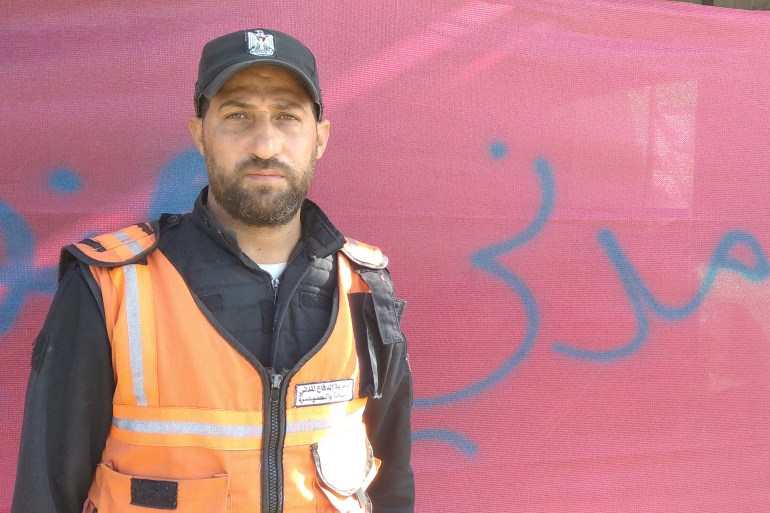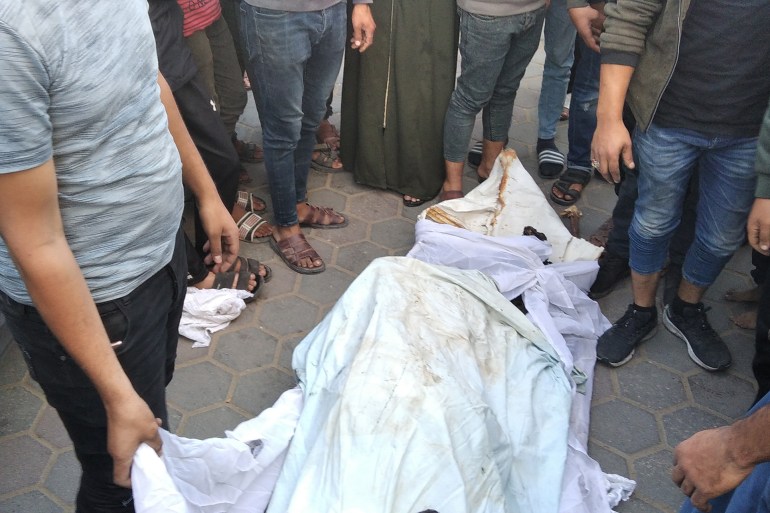The Gaza truce…is a policy of opportunity to recover as many bodies of martyrs as possible

Al Jazeera reporter
Gaza- Since the early hours of the morning, Ibrahim Sadudi led a team from the Civil Defense Department to set out for the Central Province in the Gaza StripSearch for bodies trapped under the rubble of a destroyed house.
Sadudi sees the temporary truce that began last Friday as a good opportunity to recover as many bodies as possible, as Israeli attacks make that process difficult. As a result, his team was able to rescue three martyrs, two children and a woman, from the “Salha” family of Deir al-Balah.
The team’s work depends on two basic factors: the first is the presence of the “Baqir”, a large mechanical machine capable of clearing the rubble of houses, and the second is the fuel required to operate it, which is provided by the Israeli occupying forces. has been blocked from entering the Gaza Strip since.“Aqsa Flood” On the 7th of last month.
Al Jazeera accompanied the Civil Defense team on a mission that targeted a destroyed house in the Deir al-Barakah area. After several hours of work, the team found no bodies and moved to another house.

diesel crisis
“We are using the truce to recover bodies, but the problem is providing diesel to run (Al-Baqir) because it requires 250 liters to run for eight hours,” and this quantity does not exist, Sadudi told Al Jazeera. . ” explained that the amount of diesel available would only allow them to operate the bagging machine for 2 to 3 hours a day.
He explained that the Civil Defense Directorate of the Central Province has not yet received any fuel entering the Gaza Strip, including Provisional armistice and prisoner exchangethe agreement provides for the entry of approximately 200 truckloads of aid into Gaza, including diesel and cooking gas.
“After the explosions stopped, we found quite a few bodies, but if there was diesel, the number would have doubled,” Sadudi added, noting that families whose houses were destroyed were being communicated with, urging them to rescue trapped people. The bodies of children are under the rubble and some families are trying to find them. Solar energy could help the Civil Defense Forces, but it is not available on the market.
He emphasized that even if the truce period is extended to 10 days, it will not be enough to remove all the bodies because israeli occupying forces In addition to fuel shortages, many homes were destroyed.
The spokesman said that if there was fuel, the lives of many martyrs could have been saved because they could not be rescued immediately after the attack and they died under the rubble.
Yesterday Monday, the Civil Protection Agency said in a press statement that 150 martyrs were rescued from under the rubble in the first four days of the truce. Deir al-Balah, a source at Al-Aqsa Martyrs Hospital, also told Al Jazeera that the number of recovered bodies arriving at the hospital reached 65, including 35 men and 30 women.

Volunteers recover bodies
The process of recovering bodies is not limited to civil defense personnel, volunteers are also tasked with transporting bodies from streets and areas close to where Israeli occupying forces are located.
Al Jazeera reported that volunteers retrieved nine “burnt” bodies from Al-Rashid Street, including two fetuses, belonging to the families of Abu Al-Jidyan, Al-Namnam, Abu Riyala and Azzam.
Thirty-eight members of these families were martyred on 3 November in Al-Rashid Al-Sahel Street in southern Gaza City while fleeing in a truck from the northern Gaza Strip to an area claimed by the occupying forces. Safe” and they fired several rounds at them.
Except for a man and a girl, none of the passengers in the truck survived. At that time, some passers-by found most of the martyrs, except for seven people and two fetuses, who could not be transported as the occupying forces opened fire on anyone approaching the site.

witness the massacre
Nabil Nannan, a survivor of the massacre, said they responded to orders from the occupying forces and fled to the southern Gaza Strip, boarding a truck carrying dozens of women, children and men, but the occupying forces bombed The truck was south of Gaza City.
Al-Namnam added in an interview with Al Jazeera, “In front of the power station (in southern Gaza) we were bombed and to my surprise I was lying on my back and the explosion threw me out of the power station. “Truck,” continued, “I raised my height a little and saw that everyone around me was being blown to smithereens. There are 40 of us. “Women, men and children, all died except me and my niece Jana Abu Riyala. 4 years old. God miraculously saved her.”
He stated that he lost his wife and 4 children in the massacre: Moatasem (17 years old), Remas (13 years old), Muhammad (4 years old) and Malak (3 years old), and finally said that he crawled eastward and left the scene, He was not found until he walked several hundred meters and was taken to the hospital by citizens.

Source link





